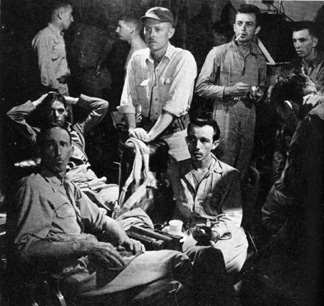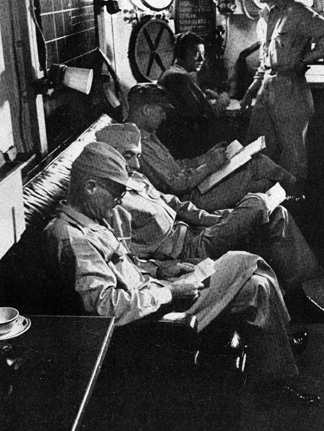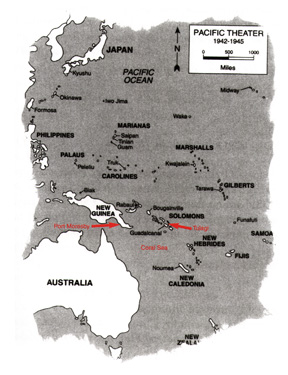|
U.S. Naval Aviation In the South Pacific during WW II Featuring the Lexington Aircraft Carrier The Battle of the Marianas — June 1944 Chapter 1 Page 4 of 7 Pages |
||||||||||||
| June 16: Widhelm tells me he has bet a thousand dollars that the Japanese fleet, whose movement was reported four days ago, will not only turn up but engage us in a carrier duel. This bet has been covered by several fighter pilots, who are hoping such a duel will materialize so that they can improve their scores of Japanese planes shot down.
June 17: The exact location and intention of the Japanese fleet were the chief topics of scuttlebutt today on the bridge and elsewhere. Indications seem to show that the fleet consists of two major units which joined together northeast of the Philippines. It comprises perhaps nine carriers populated by about 450 planes as its main striking instrument. With them of course is the usual complement of battleships, cruisers, destroyers and oilers, up to a total of perhaps 50. Our surface forces and the Japanese will certainly not meet at all until after the carrier planes have battled at a long range; and not even then if the side that loses the carrier battle can contrive to get away. June 18: Church services were held today, which apparently is Sunday. The chaplain said he expected them to be well attended and they were. The hymns seemed to be a bit on the somber side: Lead, kindly Light amid the encircling gloom and, of course, the one about the perils of the sea. After the services the loudspeaker issued an order; “Unrig church!” Tonight we swung back on an eastward course, apparently paralleling or slightly converging with the course of the Japanese. General quarters at dusk were attended with considerable tension but nothing happened. A battle tomorrow, however, looks like a reasonable certainty. |
||||||||||||
| June 19: It is difficult, perhaps impossible, to convey what happens on board a carrier during a major battle. The battle fought by our task force today resulted in the destruction of 402 Japanese planes and 27 of ours. This represented not only the all time record for a carrier action, but the world’s all-time one-day record for plane destruction and was more than twice as big as the one established on the September day in 1940 when the Germans lost 185 planes in the London blitz. Our own contribution to the day’s total, 45 planes, also approached a record for a single carrier’s air group. |
||||||||||||
 |
||||||||||||
|
Ctsy: “Mission Beyond Darkness” by Bryan and Reed |
||||||||||||
| Yet any civilian’s idea of the way in which this activity was reflected on board ship would almost surely be at variance with the facts. The day was different from other days, but the difference expressed itself in not more but less commotion than usual, ass though the ship had been the theoretically static point at the hub of a wheel or the calm at the center of the storm.
General quarters sounded shortly after reveille. At their battle stations, guncrews and deckhands, machinists and messboys discussed the situation and learned by the ship’s grapevine that the Japanese fleet had not yet been located but that it probably would be in the course of the day. |
||||||||||||
| The flag bridge to which I had been assigned as a battle station, was, of course, the origin of the best scuttlebutt on the ship. When I got there Admiral Marc Mitcher, his baseball cap pulled down well over his eyes, was already perched in his usual position, facing aft, hunched up in a little chair. In flag plot, the room for which the bridge made a verandah on three sides, Captains Burke and Hedding, chief and deputy chief of staff respectively, were seated together on a leather sofa, talking. The room was full of the harsh buzz of the intership radio. A yeoman sat quietly at his desk in the corner taking down a stenographic record of this talk between ships. Other officers sat at the plotting desk or tinkered with various gadgets, gauges or radios with which flag lot is furnished.
In the hour between darkness and complete daylight, which I spent either in flag plot or on the bridge itself, I got a fairly clear picture of the situation in the course of chats with several officers. While we did not yet know the exact position of the Japanese fleet, we were reasonably sure that it was approximately due west of us, about 350 miles away. all of the task groups in our task force — each group composed of several carriers and a complement of escort vessels — were massed between the enemy and the string of islands to our east and northeast, of which the closest was Guam. To stay between our Marine invasion on Saipan and the Japanese fleet, we had been on an easterly course all the night before. This had a positive advantage of protecting our forces on the island but the probable disadvantage of preventing us from getting in close enough to the Japanese fleet to deliver the first blow —as important in a carrier duel as it is in a barroom brown — by means of a dawn attack. |
||||||||||||
 |
||||||||||||
|
Ctsy: Life Mag., dated 6/17/44 |
||||||||||||
 |
||||||||||||
|
|
||||||||||||
| Our position also gave the Japanese an opportunity, of somewhat doubtful value as it developed, to fly their planes over us, land at Guam, reload and refuel and then shuttle back to their carriers, striking at us a second time en route.
After breakfast tension about the battle began to drop. It began to seem quite credible that the Japanese fleet had really never been on hand at all, or that it had withdrawn on getting wind of the size of our force or that, for one reason or another, no battle would materialize. officers left the wardroom tables to shave, take showers or to nap for a few minutes. I was back in my room dozing comfortable half an hour later when around 9 o’clock two blasts on the boatswain’s pipe and then the loud repeated bell of the general-quarters signal sounded for the second time. This everyone knew at once meant that enemy planes had been spotted; and that the battle, after all, was to happen. In flag plot, by the time I got there, the situation was clear enough. “Bogeys” were approaching us in two large groups of undetermined size. Admiral Mitscher, sitting now in the corner of the leather sofa in flag plot, wore a slightly grim smile. “Are you excited” he asked me. I said that I was. The admiral made a small sound that was half a growl and half a laugh. “So am I,” he said. About ten minutes after the fighters took off we learned that they had sighted a group of Japanese planes closing on the task force from the west. At about the same time, from the starboard side of the bridge where I was standing, tiny puffs of smoke began to be discernible along the horizon where ships in another task group were already firing their antiaircraft guns. The puffs mounted into the sky; other puffs, larger now, rose from the ships at the edge of our own group. Suddenly the firing became audible, as the cruiser off our starboard quarter began shooting. I followed the horizontal flicker of tracer bullets, barely perceptible in the bright sunlight and saw the first Japanese plane, a torpedo bomber, coming in low over the water. When still well astern of the cruiser and a good half mile astern of us, the plane hit the water and vanished in a little puff of smoke and spray. Chapter 1— End of Page 4 of 7 Pages — Go to Page 5 Page —1 — 2 — 3 — 4 — 5 — 6 — 7 Or This Story’s Cover Page — Editor’s Introduction — Table of Contents Fred Gwynn’s “Torpedo 16” — Chapter — 1 — 2 — 3 — 4 Or Home - Contact Us - Cold War Hist. - 91st SRS Hist. - Stardust 40 Mission Story |
||||||||||||